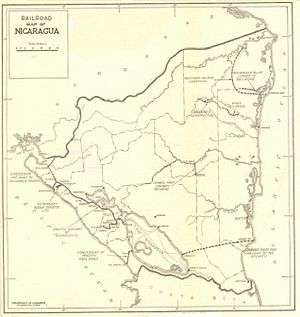History of rail transport in Nicaragua
- This article is part of the history of rail transport by country series
The history of rail transport in Nicaragua began in 1860s, with the first plans for a railroad in Nicaragua. The first line was opened in 1882. In the past, there were 3 ft 6 in (1,067 mm) gauge railroads on the Pacific coast, connecting major cities. A private 4 ft 8 1⁄2 in (1,435 mm) gauge line operated on the Atlantic coast.
However, as of 2006, there were no longer any trains in Nicaragua. All traffic has been suspended since September 2001,[1] ending several decades of a steady decline.
Beginnings
For an easier understanding, follow the narrative on a map.
First projects for the construction of railroads in Nicaragua were considered in the 1860s. In 1873, the government signed contracts with J. E. Hollembeck & Co. for building a line between Managua and Granada, and with Enrique Meiggs Keith for a line from Corinto to León. However, there were no practical results.
In 1876, President Pedro Joaquín Chamorro Alfaro enacted a decree, calling for a construction of a railroad from Corinto via Chinandega and León to the nearest port on Lake Managua (later Western division). The railroad would be connected to the capital through steamboats. Another section of railroad (later Eastern division) should be built from Managua to Granada via Masaya or along the Tipitapa river.
Works on the Western division started in 1878. The first engine arrived at Chinandega in November 1880, and the first segment - Corinto to Chinadega - was completed and put into operation March 10, 1882. Construction continued and in 1883, the railroad reached the city of León and León Viejo, a settlement on the bank of Lago de Managua. A new city, Puerto Momotombo, was inaugurated in 1884 to serve the port and transshipment station. The western division had 58 miles (93 km) of the main line plus 3.5 miles/5.6 km of secondary lines.
The construction of the Eastern division commenced in Nicaragua in 1883. In 1884, the line reached Masaya and the construction was completed in 1886 in Granada. The division had 31 miles/49.9 km of main line, plus 2 miles/3.2 km of secondary lines.
In 1885, a contract was signed for the construction of Ferrocarril a Los Pueblos de Carazo, branching from the "Eastern division" in Masaya towards Diriamba, across an area of coffee farming. The line, 27 miles/43.5 km long and including a 30 m long tunnel, was completed in 1887.
In 1895-98, a branch Chinandega - El Viejo (4.8 miles/7.7 km) extended from the Western division.
Twentieth century

The Central division, connecting the Western and Eastern divisions between La Paz Vieja and Managua, was constructed from 1900 - 1902. This made obsolete the steamboat connection across Lago de Managua and the branch to Puerto Momotombo was abandoned in 1903.[2]
There were plans to extend the network to the Atlantic coast. A contract was signed in 1903. The line should have stretched 288 km from San Miguelito (a port at Lake Nicaragua) through a difficult terrain to Monkey Point at the Caribbean coast. In 1909, after constructing about 10 miles/16.1 km of tracks, the works stopped and never resumed again. Nicaraguan railroads never connected both coasts. Private investors later built an isolated 62 miles/100 km-long standard gauge line between Puerto Cabezas and Cocoland. It operated from 1925 until 1955 and was used mainly for a transport of lumber and bananas.[3]
Additional lines on the Pacific coast were built in the subsequent decades. In 1940, the National Railroads consisted of the following lines:
- Corinto - Granada 191.98 km
- Masaya - Diriamba 43.49 km
- León - El Sauce 72.00 km
- San Jorge - San Juan del Sur 31.00 km
- Chinandega -Puerto Morazán 31.00 km
- El Sauce - Río Grande 13.00 km
Total: 382.48 km
In the 1960s and 1970s, the railroad went into a decline, exacerbated further by the Managua earthquake of 1972. The government reacted to this by constructing a 25.4 km branch from Ceiba Mocha to Puerto Somoza (now Puerto Sandino) in 1976. This significantly increased productive operations and revenues, but did not reverse the long-term trend. Governmental subsidies were steadily increasing and passenger transport declining.[4] The oldest line Corinto - León was abandoned in 1982 [5] when floods damaged tracks. In 1993, there were still 373 km of 3 ft 6 in (1,067 mm) narrow gauge tracks in the Pacific region and isolated 3 km of 4 ft 8 1⁄2 in (1,435 mm) standard gauge line at Puerto Cabezas in the Caribbean. Several trains a day carried passengers south from Managua to Granada, or north from the capital to León.[6]
Closure

Most lines were shut down on December 31, 1993 by President Violeta Chamorro who ordered the rolling stock and rail demolished and sold for scrap.[7] The last one - 6 km from Chichigalpa to Ing. S. Antonio - was decommissioned in September 2001.
FERISTSA
The FERISTSA Railway was proposed to connect Mexico with Panama via Nicaragua.[8]
See also
References
- ↑ Hock, M(2001): News from Nicaragua. At www.ferrolatino.ch
- ↑ http://www.fahrplancenter.com/NicaraguaMomotombo.html Line La Paz Vieja - Puerto Momotombo at Ferrolatino.ch
- ↑ Line Puerto Cabezas - Cocoland on Ferrolatino.ch
- ↑ Breve Historia del ferrocarril de Nicaragua at www.manfut.org (main source for this article)
- ↑ Line Corinto - León on Ferrolatino.ch
- ↑ Country Studies - Nicaragua - Transport from the Library of Congress
- ↑ Hock, M(2000): Ferrocarril del Ingenio San Antonio at Ferrolatino.ch
- ↑ "Shaw Group in talks with US railroad cos for Feristsa project, Central America, Infrastructure, news". Retrieved 2010-10-16.
External links
![]()
- Historical pictures of Chichigalpa - Ing. S. Antonio line (note: displayed pictures change dynamically; refresh page or switch English/Espaňol to see others)
- Pictures of old train stations in Masaya and Granada
.jpg)